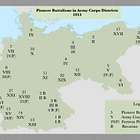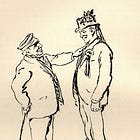Welcome to the Tactical Notebook, where you will find more than four hundred tales of armies that are, armies that were, and armies that might have been. If you like what you see here, please share this article with your friends.

During the first half of August of 1914, the mobilization authorities of the German Empire raised fifty-four immobile pioneer companies. While up to establishment where men were concerned, these units lacked many of the items, whether wagons, field kitchens, or field gray uniforms, normally provided to organizations serving with formations in the field. Thus, they could only perform duties in the vicinity of places, such as fortresses and towns, where their men, who tended to be much older than those of active, Reserve, and Ersatz pioneer companies, could find billets in private houses, public buildings, or barns.
Of these fifty-four companies, forty filled their ranks with men of the Landsturm. Named after the Prussian partisans who resisted Napoleon in 1813, the Landsturm consisted of reservists between the ages of forty and forty-five, few of whom had participated in any sort of military training during the past twenty years or so. The remaining companies were affiliated with the Landwehr, which was composed of men between the ages of 27 and 39.
As a rule, the authorities charged with mobilization sent younger Landwehr men to Reserve units, Landwehr men of middling age to mobile Landwehr units, and the oldest Landwehr men to immobile Landwehr units. Thus, some of the men who served in the fourteen immobile Landwehr pioneer companies were nearly as old as those who served with Landsturm pioneer companies.
As vehicles, horses, and field gray clothing became available, the immobile pioneer companies were transformed into mobile units. In the case of the fourteen immobile Landwehr companies, this transformation took place before 1 September 1914. In the four months that followed, twenty-nine of the forty Landsturm pioneer companies formed in August of 1914 followed suit.
Whether mobile or immobile, pioneer companies of both the Landwehr and the Landsturm bore names that indicated their army corps district of origin. Thus, for example, the senior Landwehr pioneer company of the district of the IV Army Corps was known as the 1st Landwehr Pioneer Company IV Army Corps [1. Landwehr Pionier Kompanie IV. Armee Korps]. Likewise, the second Landsturm pioneer company affiliated with the IV Army Corps district was called 2. Landsturm Pionier Kompanie IV. Armee Korps.
The Ersatz battalions of fortress pioneer battalions seem to have formed few, if any, immobile pioneer companies. Instead, they left this task to the training and replacement units of ordinary pioneer battalions. As the number born by an ordinary pioneer battalion often matched that of the army corps district in which it was located, the designations bourn by pioneer companies of the Landwehr and Landsturm often corresponded with those of the Ersatz battalions that had formed them. Thus, for example, the Ersatz battalion of the Pionier Battalion 1 raised all of the Landsturm and Landwehr pioneer companies of the I Army Corps.
Sources:
Wilhelm Calsow Samländisches Pionier-Bataillon Nr 18 [Samland Pioneer Battalion Number 18] (Oldenburg: Gerhard Stalling, 1922)
Adolf Günther Erinnerungsblätter an die Teilnahme des Pionier Bataillons Fürst Radizwill (Ostpreußisches) Nr. 1 am Weltkriege 1914-1918 [Remembrance Book of the Participation of the Pioneer Battalion Prince Radizwill (East Prussian) Number 1] (Oldenburg: Gerhard Stalling, 1922) pages 60-94
Paul Heinrici Das Ehrenbuch der Deutschen Pioniere [The Honor Book of the German Pioneers] (Berlin: Wihelm Kolk, 1931) pages 61-62
Offizier-Vereinigung des Bataillons [Officers’ Assembly of the Battalion] Königlich Preußisches Magdeburgisches Pionier-Bataillon Nr 4. 1914-1918 [Royal Prussian Magdeburg Pioneer Battalion Number 4 1914-1918] (Zeulenroda: Bernhard Sporn, 1935) pages 210-242
Hans Trödel and Artur Leipold Das Posensche Pionier-Bataillon Nr. 29 und seine Kriegsformationen [The Posen Pioneer Battalion Number 29 and Its Wartime Units] (Berlin: Wilhelm Kolk, 1932)
Karl Witte 3. Rheinisches Pionier-Bataillon Nr. 30 [3. Rhineland Pioneer Battalion Number 30] (Oldenburg: Gerhard Stalling, 1928)
For Further Reading:









